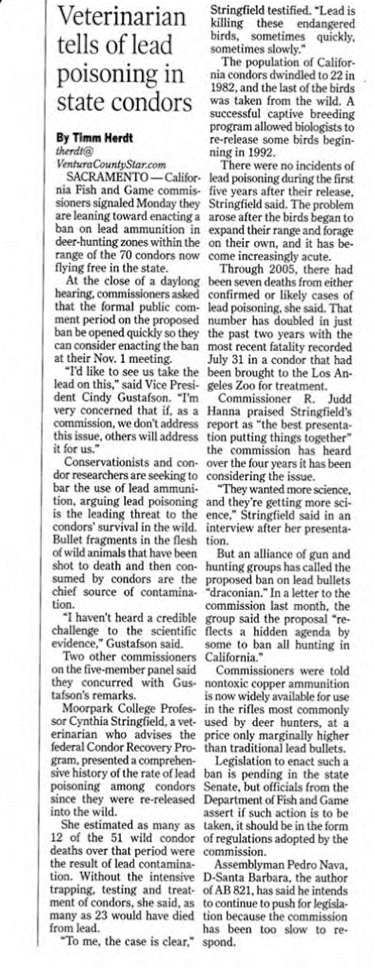Cynthia E. Stringfield, DVM
Abstract
The California condor continues to thrive and succeed in captivity, but challenges to the success of the reintroduction program exist due to the highly degraded nature of the environment they are released into.
Lead poisoning is the number one medical problem of released California condors with regards to morbidity and mortality, and therefore the most serious threat to the recovery of the species in the wild. A major event occurred in the California condor program in California in the last year relating to lead poisoning in released birds in the state. In the fall and winter of 2007, after years of testimony and requests, the California Fish and Game Commission approved a ban of lead ammunition in the condor’s range in California. This came immediately after a bill to do the same, AB 821, by Assemblyman Pedro Nava, D-Santa Barbara, was signed into law by Governor Arnold Schwarzenegger. The Fish and Game Commission extended the restrictions in the bill, which was less inclusive, to include all rifle and pistol ammunition within condor country (a V-shaped swath of land comprising approximately one-fifth of the state) including hunting of nongame animals such as wild pigs, coyotes, and rodents. At this writing, as we wait for the ban to begin on July 1, seven birds were hospitalized at the Los Angeles Zoo for treatment for lead poisoning, including a several-month-old wild-fledged chick and its mother.
A strong veterinary program made a vital contribution to the success of this ban finally passing. Testimony by the Species Survival Plan (SSP) veterinarian (also the field veterinary coordinator) presented scientific data analyzed in conjunction with a well-respected toxicologist involved in the banning of DDT, Robert Risebrough, and the head pathologist and head of condor pathology at the Zoological Society of San Diego, Bruce Rideout. Statistics were presented regarding mortality in California, proposed mortality rates if birds did not continue to receive invasive screening and intervention with chelation therapy provided by the field personnel and the Los Angeles Zoo. These were coupled with concerns backed by scientific human and veterinary medical data for the long-term implications of chronic lead exposure in adults and offspring now being hatched in the wild (Figure 1).
Figure 1. Ventura County Star 8/28/2007 “Commissioners near bullet ban”

Chicks hatching in the wild in southern California have suffered due to the ingestion of small pieces of trash (termed microtrash) fed to them by their parents. Due to the intensive involvement by veterinary and condor staff at the Los Angeles Zoo (impossible without the support of the USFWS), an aggressive proactive monitoring and intervention plan is succeeding in decreasing mortality of these birds.
Acknowledgments
Keeping these birds flying in the wild would be impossible without the tremendous dedication of all condor biologists and volunteers, and the condor and veterinary staffs of the Los Angeles Zoo, San Diego Zoological Society, the Phoenix Zoo, and the Oregon Zoo. We all aim for the same goal: A day when our intervention is no longer needed.